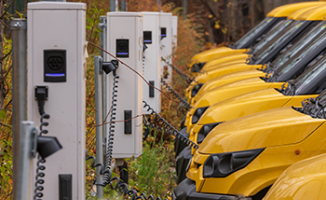-
What We DoFrom fleet management and productivity solutions to upfitting, fabrication, and insurance, Holman has the integrated automotive services expertise to keep your business moving.Overview
-
ResourcesWe have a lot to share. Browse our resources library for current insights, data, strategies, and success stories from our own experts in their respective fields.Overview
-
About UsWhen Holman was founded in 1924, we set something positive in motion. Our consistent focus on people and our commitment to integrity make us who we are today.Overview
 Join Our TeamWe’re not just in the automotive business, we’re in the people business. Join us for the ride.Browse Careers
Join Our TeamWe’re not just in the automotive business, we’re in the people business. Join us for the ride.Browse Careers
Doing the Math: Making EVs Work for Your Budget
Holman Marketing
March 17, 2021

We’ve learned about how you can use your telematics to build a better strategy for electric vehicle (EV) implementation and how to build a stronger starting point, but one question still remains: How will you afford this major change?
The financial investment in an electric fleet is just as important as the job those vehicles will do, and to get a full look at your purchase, you need to look at its entire lifespan. Let’s take a look at the whole picture, studying the Buy, Drive, Service, and Sell lifecycle to understand the costs and benefits around an EV fleet.
BUY
EVs have developed a reputation for being expensive upfront, but advancements in battery life are changing the game and making them a serious consideration. So what does purchasing an EV look like in your market?
Your data is a major influencer in deciding these costs. Take a look at your fleet locations and the manufacturers operating in those areas to see how OEM production and delivery costs can influence your initial spend. You might find that purchasing in different regions is the best way to go, or that it’s more affordable to purchase hybrid varieties in different work areas.
DRIVE
Investing in EVs has the exciting potential of cutting fuel spending, but you don’t want to replace those costs with towing charges if your vehicles’ batteries do not have enough boost for the mileage or the auxiliary power you need on the job. Make sure you study your telematics data to understand how your vehicles travel and build your buying plan around that information.
There are batteries out there that drive hundreds of miles on one full charge, but you need to make sure the vehicles also fit your job requirements. If those elements don’t line up, consider how the cost of fuelling hybrid fleets could benefit your interests instead.
SERVICE
EVs also mean the end of regular oil changes: How will that added savings benefit impact your bottom line? Take a look at your preventative maintenance history to see how often you are managing petrol-powered maintenance requirements, then compare that to the costs of EV investments. You might be surprised by just how much time and money you can save.
If you operate in-house garages, make sure you invest in EV training for your maintenance team. It’s easy with telematics, as you are able to use past training history to understand your team’s knowledge background and build training schedules that are managed directly through your online system.
SELL
How will you sell your petrol vehicles, and what is your remarketing strategy for your new EV fleet? There are simple solutions with the help of… you guessed it… telematics. Build a replacement schedule entirely using your data, which can give first priority to the older vehicles that are not living up to the potential of your fleet, and build a dedicated plan to replace those vehicles with new EV options.
You can even use this data to time replacement schedules alongside infrastructure developments, allowing you to determine how many charging stations you need and where they will be built. And you can manage those changes without compromising the size or performance of your fleet over time.
Think differently about your fleet lifecycle. Click here to learn more about buy-drive-service-sell and how that model works for your business. Also, subscribe to the Morning Brake, to learn more about Holman and industry trends.
Related Resources
Explore more related industry news, insights, and developments.
It looks like you've navigated to our Holman UK website and are located outside of this region. Would you like to continue or select a different region?
✕







